The Economics of Pay for Performance and Efficiency Wage Models
VerifiedAdded on 2023/06/10
|12
|2197
|225
Report
AI Summary
This report examines the economic principles of pay for performance and efficiency wage theory, focusing on their influence on productivity, employee motivation, and labor market dynamics. The study begins by defining pay-for-performance schemes and their role in incentivizing workers to enhance their output. It then delves into efficiency wage theory, which posits that firms can boost productivity and reduce costs by paying wages above market-clearing rates. The report explores the benefits of efficiency wages, including increased worker effort, decreased employee turnover, and attraction of high-quality employees. The analysis incorporates models like adverse selection and shirking, and the backward-bending labor supply curve. The report also presents empirical evidence, such as the Safelite Glass Corporation case, to illustrate the effectiveness of these theories in practice. Furthermore, it discusses the impact of wage differentials, and concludes by emphasizing the importance of considering factors like worker motivation and the proper implementation of efficiency wage models. The report offers a comprehensive analysis of these crucial concepts in human resource economics.
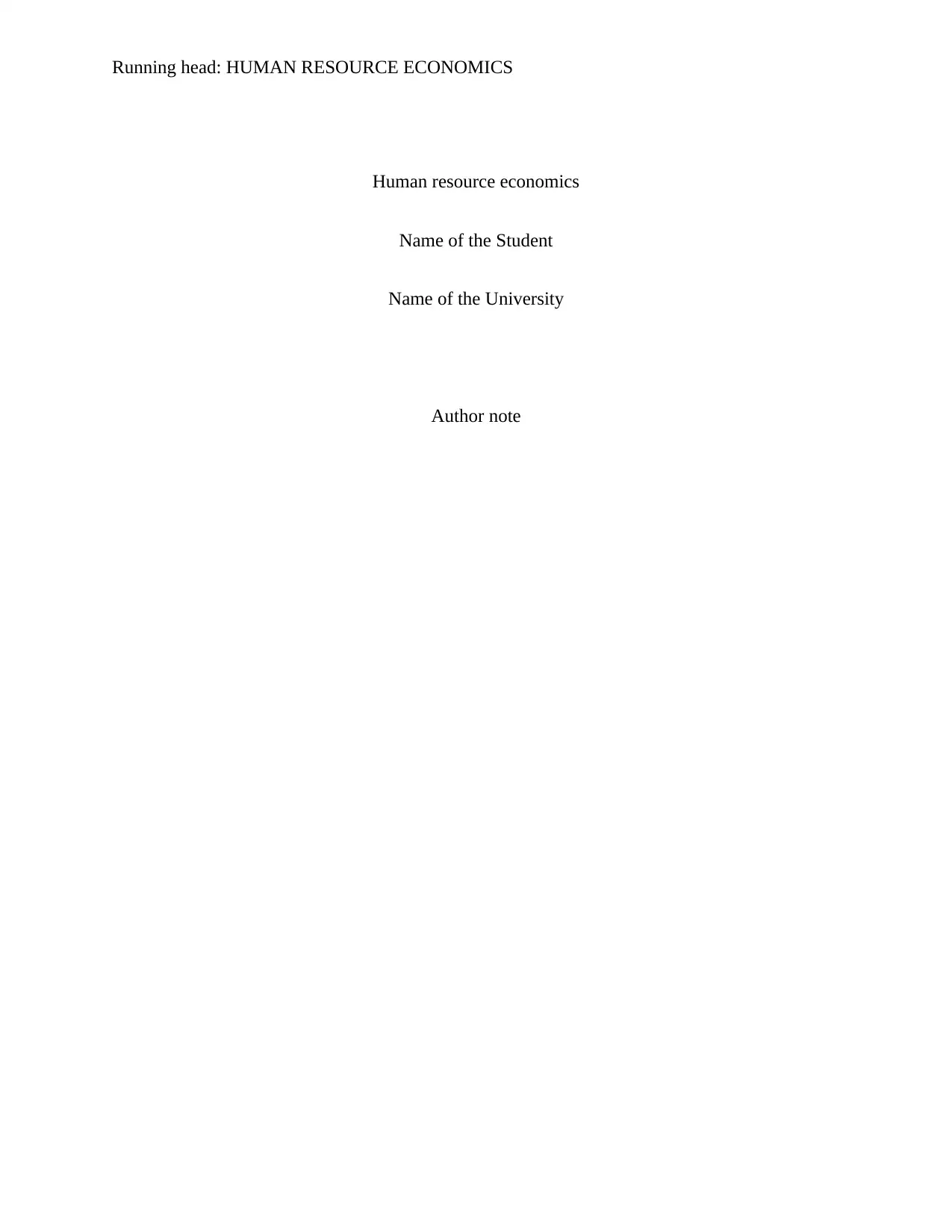
Running head: HUMAN RESOURCE ECONOMICS
Human resource economics
Name of the Student
Name of the University
Author note
Human resource economics
Name of the Student
Name of the University
Author note
Paraphrase This Document
Need a fresh take? Get an instant paraphrase of this document with our AI Paraphraser
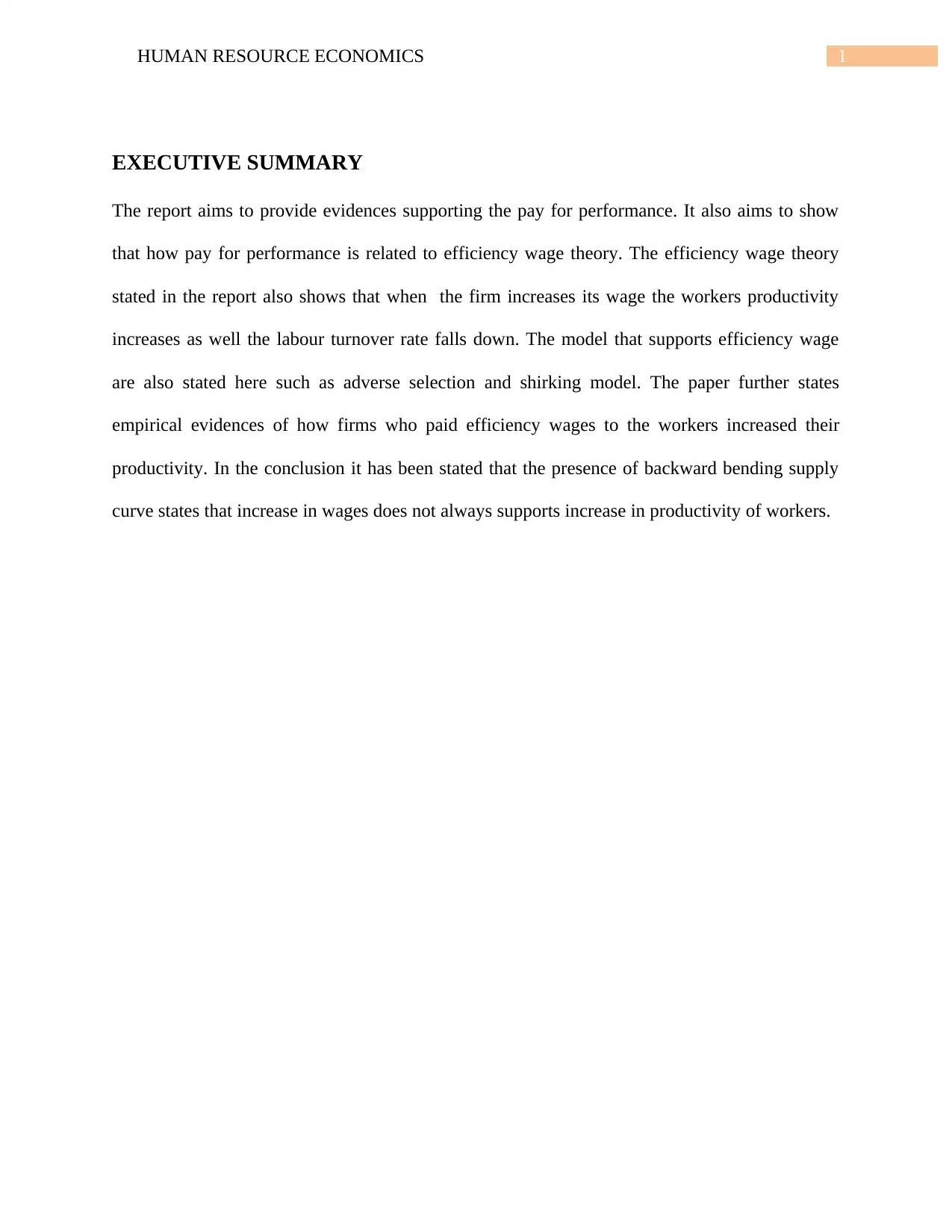
1HUMAN RESOURCE ECONOMICS
EXECUTIVE SUMMARY
The report aims to provide evidences supporting the pay for performance. It also aims to show
that how pay for performance is related to efficiency wage theory. The efficiency wage theory
stated in the report also shows that when the firm increases its wage the workers productivity
increases as well the labour turnover rate falls down. The model that supports efficiency wage
are also stated here such as adverse selection and shirking model. The paper further states
empirical evidences of how firms who paid efficiency wages to the workers increased their
productivity. In the conclusion it has been stated that the presence of backward bending supply
curve states that increase in wages does not always supports increase in productivity of workers.
EXECUTIVE SUMMARY
The report aims to provide evidences supporting the pay for performance. It also aims to show
that how pay for performance is related to efficiency wage theory. The efficiency wage theory
stated in the report also shows that when the firm increases its wage the workers productivity
increases as well the labour turnover rate falls down. The model that supports efficiency wage
are also stated here such as adverse selection and shirking model. The paper further states
empirical evidences of how firms who paid efficiency wages to the workers increased their
productivity. In the conclusion it has been stated that the presence of backward bending supply
curve states that increase in wages does not always supports increase in productivity of workers.
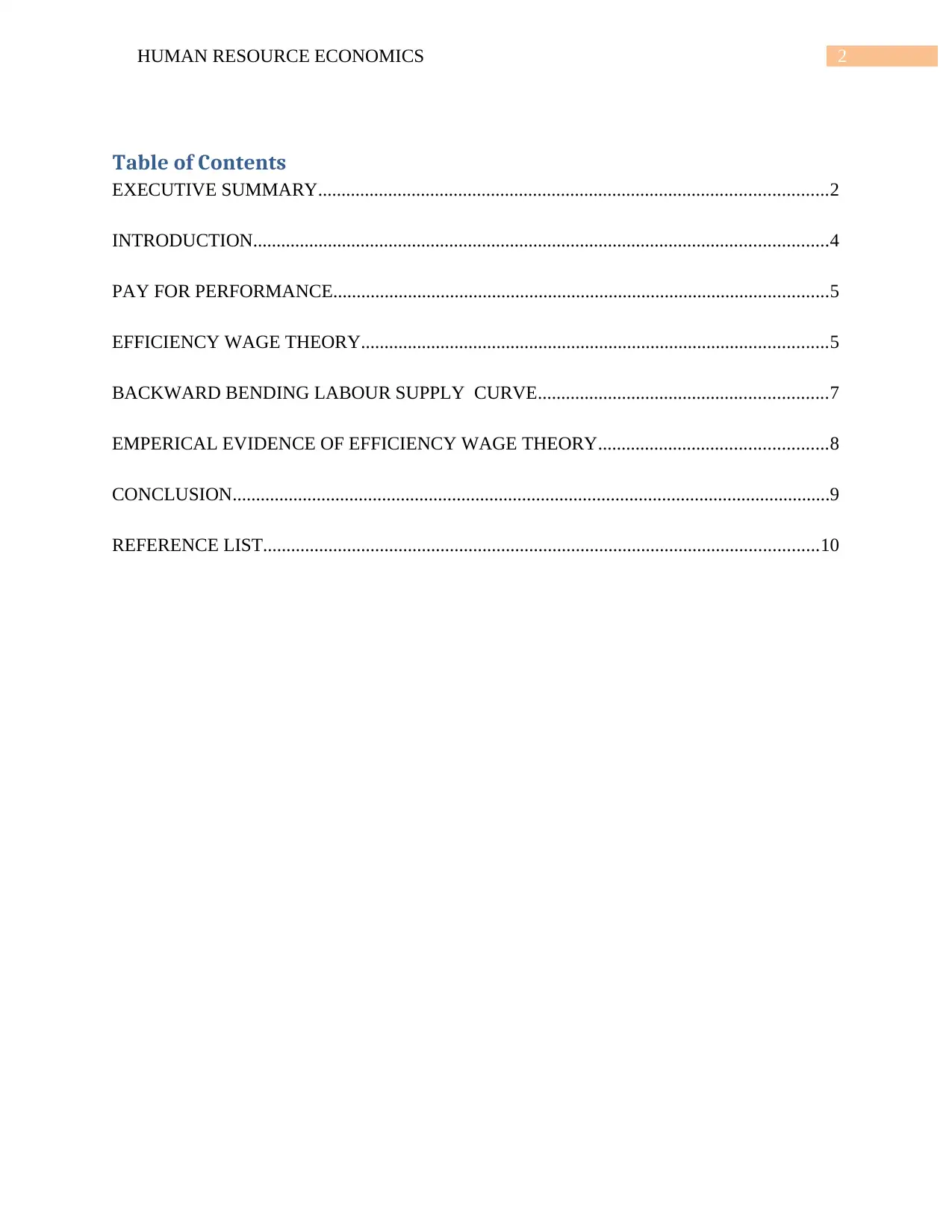
2HUMAN RESOURCE ECONOMICS
Table of Contents
EXECUTIVE SUMMARY.............................................................................................................2
INTRODUCTION...........................................................................................................................4
PAY FOR PERFORMANCE..........................................................................................................5
EFFICIENCY WAGE THEORY....................................................................................................5
BACKWARD BENDING LABOUR SUPPLY CURVE..............................................................7
EMPERICAL EVIDENCE OF EFFICIENCY WAGE THEORY.................................................8
CONCLUSION................................................................................................................................9
REFERENCE LIST.......................................................................................................................10
Table of Contents
EXECUTIVE SUMMARY.............................................................................................................2
INTRODUCTION...........................................................................................................................4
PAY FOR PERFORMANCE..........................................................................................................5
EFFICIENCY WAGE THEORY....................................................................................................5
BACKWARD BENDING LABOUR SUPPLY CURVE..............................................................7
EMPERICAL EVIDENCE OF EFFICIENCY WAGE THEORY.................................................8
CONCLUSION................................................................................................................................9
REFERENCE LIST.......................................................................................................................10
⊘ This is a preview!⊘
Do you want full access?
Subscribe today to unlock all pages.

Trusted by 1+ million students worldwide
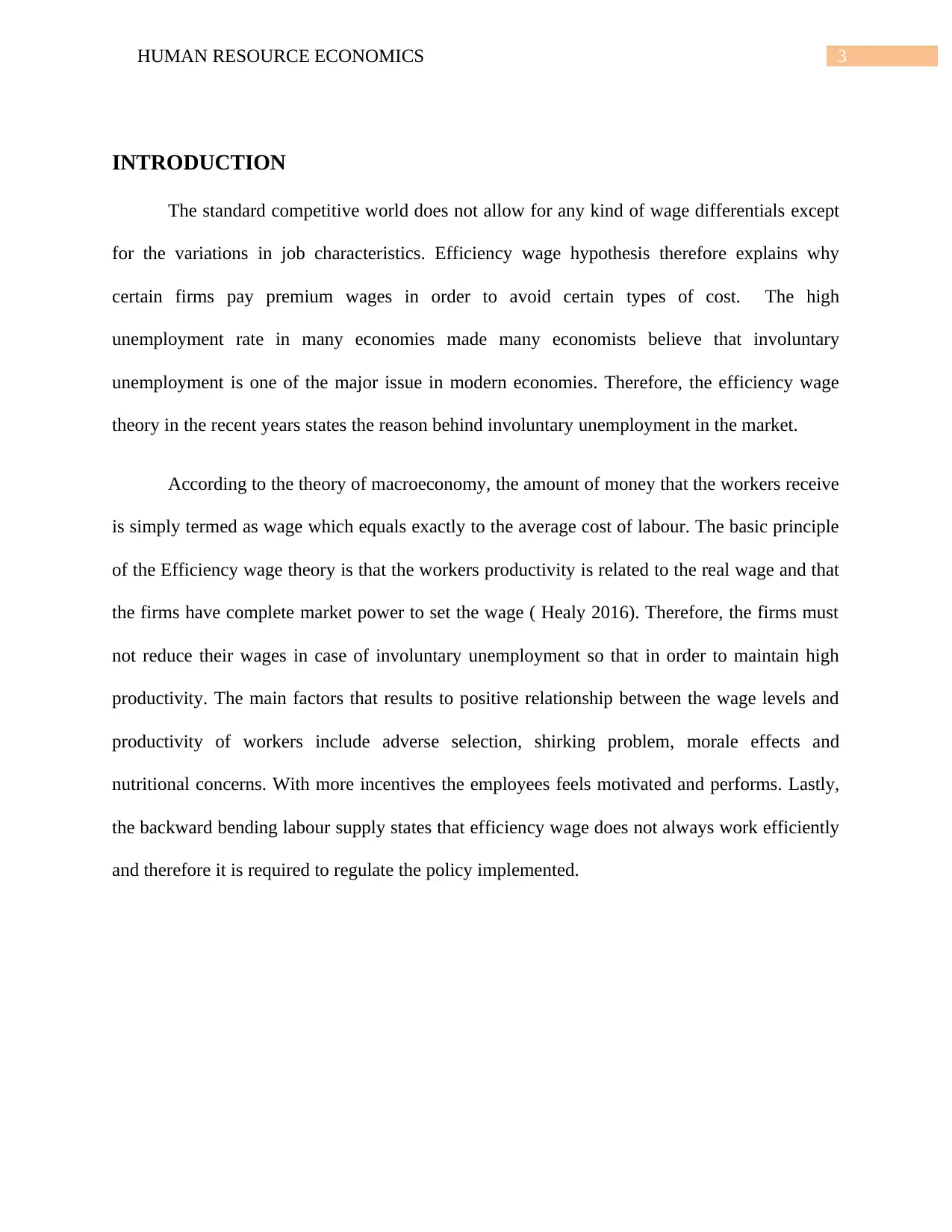
3HUMAN RESOURCE ECONOMICS
INTRODUCTION
The standard competitive world does not allow for any kind of wage differentials except
for the variations in job characteristics. Efficiency wage hypothesis therefore explains why
certain firms pay premium wages in order to avoid certain types of cost. The high
unemployment rate in many economies made many economists believe that involuntary
unemployment is one of the major issue in modern economies. Therefore, the efficiency wage
theory in the recent years states the reason behind involuntary unemployment in the market.
According to the theory of macroeconomy, the amount of money that the workers receive
is simply termed as wage which equals exactly to the average cost of labour. The basic principle
of the Efficiency wage theory is that the workers productivity is related to the real wage and that
the firms have complete market power to set the wage ( Healy 2016). Therefore, the firms must
not reduce their wages in case of involuntary unemployment so that in order to maintain high
productivity. The main factors that results to positive relationship between the wage levels and
productivity of workers include adverse selection, shirking problem, morale effects and
nutritional concerns. With more incentives the employees feels motivated and performs. Lastly,
the backward bending labour supply states that efficiency wage does not always work efficiently
and therefore it is required to regulate the policy implemented.
INTRODUCTION
The standard competitive world does not allow for any kind of wage differentials except
for the variations in job characteristics. Efficiency wage hypothesis therefore explains why
certain firms pay premium wages in order to avoid certain types of cost. The high
unemployment rate in many economies made many economists believe that involuntary
unemployment is one of the major issue in modern economies. Therefore, the efficiency wage
theory in the recent years states the reason behind involuntary unemployment in the market.
According to the theory of macroeconomy, the amount of money that the workers receive
is simply termed as wage which equals exactly to the average cost of labour. The basic principle
of the Efficiency wage theory is that the workers productivity is related to the real wage and that
the firms have complete market power to set the wage ( Healy 2016). Therefore, the firms must
not reduce their wages in case of involuntary unemployment so that in order to maintain high
productivity. The main factors that results to positive relationship between the wage levels and
productivity of workers include adverse selection, shirking problem, morale effects and
nutritional concerns. With more incentives the employees feels motivated and performs. Lastly,
the backward bending labour supply states that efficiency wage does not always work efficiently
and therefore it is required to regulate the policy implemented.
Paraphrase This Document
Need a fresh take? Get an instant paraphrase of this document with our AI Paraphraser
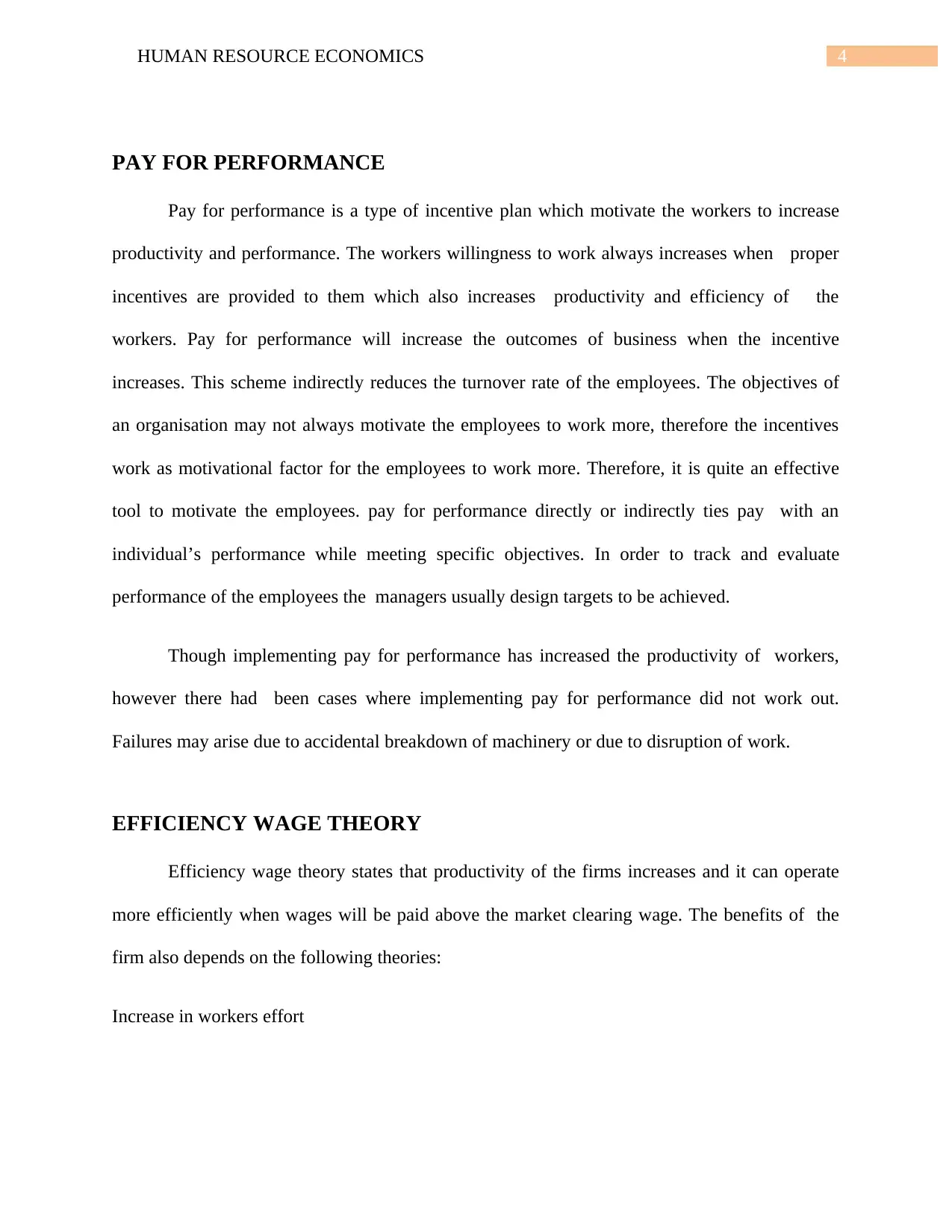
4HUMAN RESOURCE ECONOMICS
PAY FOR PERFORMANCE
Pay for performance is a type of incentive plan which motivate the workers to increase
productivity and performance. The workers willingness to work always increases when proper
incentives are provided to them which also increases productivity and efficiency of the
workers. Pay for performance will increase the outcomes of business when the incentive
increases. This scheme indirectly reduces the turnover rate of the employees. The objectives of
an organisation may not always motivate the employees to work more, therefore the incentives
work as motivational factor for the employees to work more. Therefore, it is quite an effective
tool to motivate the employees. pay for performance directly or indirectly ties pay with an
individual’s performance while meeting specific objectives. In order to track and evaluate
performance of the employees the managers usually design targets to be achieved.
Though implementing pay for performance has increased the productivity of workers,
however there had been cases where implementing pay for performance did not work out.
Failures may arise due to accidental breakdown of machinery or due to disruption of work.
EFFICIENCY WAGE THEORY
Efficiency wage theory states that productivity of the firms increases and it can operate
more efficiently when wages will be paid above the market clearing wage. The benefits of the
firm also depends on the following theories:
Increase in workers effort
PAY FOR PERFORMANCE
Pay for performance is a type of incentive plan which motivate the workers to increase
productivity and performance. The workers willingness to work always increases when proper
incentives are provided to them which also increases productivity and efficiency of the
workers. Pay for performance will increase the outcomes of business when the incentive
increases. This scheme indirectly reduces the turnover rate of the employees. The objectives of
an organisation may not always motivate the employees to work more, therefore the incentives
work as motivational factor for the employees to work more. Therefore, it is quite an effective
tool to motivate the employees. pay for performance directly or indirectly ties pay with an
individual’s performance while meeting specific objectives. In order to track and evaluate
performance of the employees the managers usually design targets to be achieved.
Though implementing pay for performance has increased the productivity of workers,
however there had been cases where implementing pay for performance did not work out.
Failures may arise due to accidental breakdown of machinery or due to disruption of work.
EFFICIENCY WAGE THEORY
Efficiency wage theory states that productivity of the firms increases and it can operate
more efficiently when wages will be paid above the market clearing wage. The benefits of the
firm also depends on the following theories:
Increase in workers effort
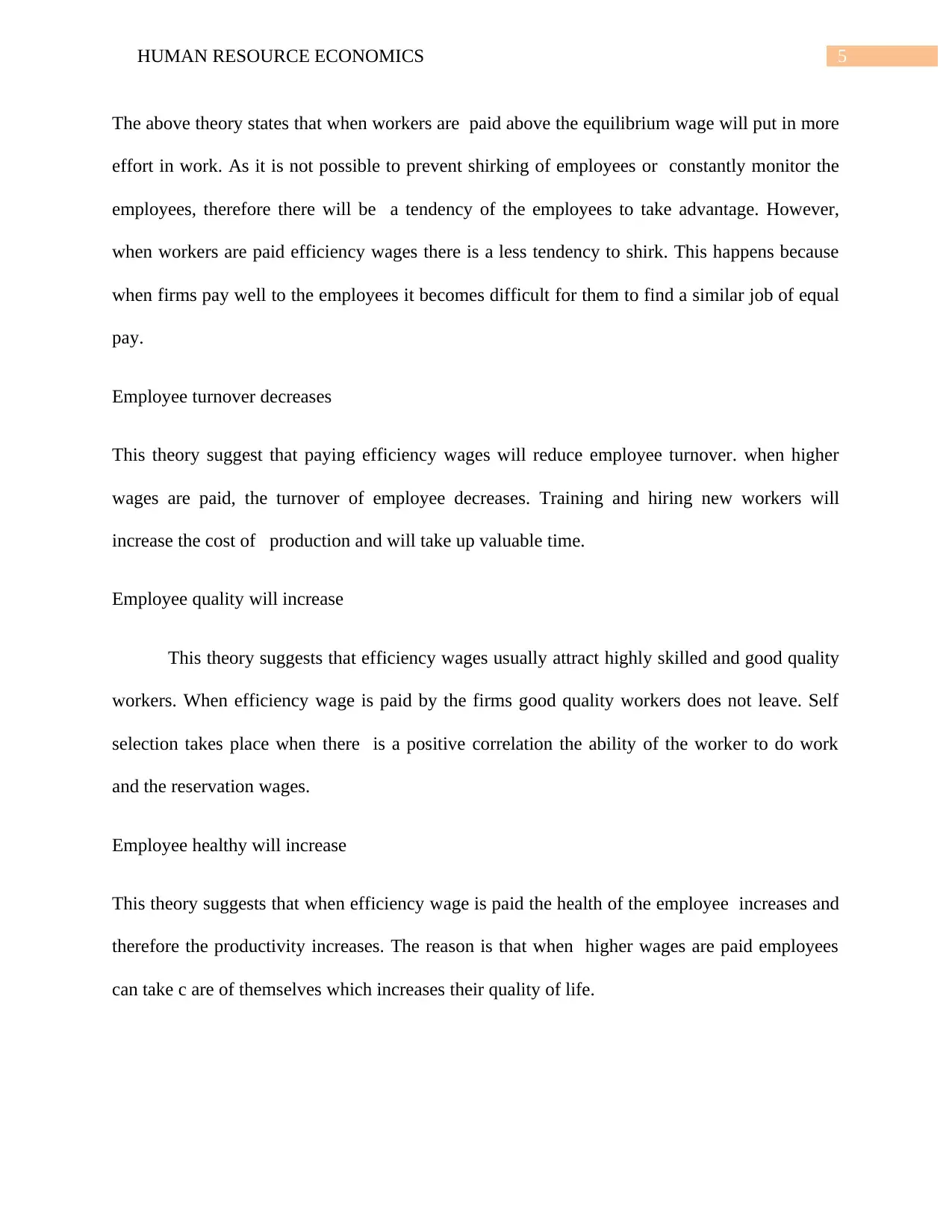
5HUMAN RESOURCE ECONOMICS
The above theory states that when workers are paid above the equilibrium wage will put in more
effort in work. As it is not possible to prevent shirking of employees or constantly monitor the
employees, therefore there will be a tendency of the employees to take advantage. However,
when workers are paid efficiency wages there is a less tendency to shirk. This happens because
when firms pay well to the employees it becomes difficult for them to find a similar job of equal
pay.
Employee turnover decreases
This theory suggest that paying efficiency wages will reduce employee turnover. when higher
wages are paid, the turnover of employee decreases. Training and hiring new workers will
increase the cost of production and will take up valuable time.
Employee quality will increase
This theory suggests that efficiency wages usually attract highly skilled and good quality
workers. When efficiency wage is paid by the firms good quality workers does not leave. Self
selection takes place when there is a positive correlation the ability of the worker to do work
and the reservation wages.
Employee healthy will increase
This theory suggests that when efficiency wage is paid the health of the employee increases and
therefore the productivity increases. The reason is that when higher wages are paid employees
can take c are of themselves which increases their quality of life.
The above theory states that when workers are paid above the equilibrium wage will put in more
effort in work. As it is not possible to prevent shirking of employees or constantly monitor the
employees, therefore there will be a tendency of the employees to take advantage. However,
when workers are paid efficiency wages there is a less tendency to shirk. This happens because
when firms pay well to the employees it becomes difficult for them to find a similar job of equal
pay.
Employee turnover decreases
This theory suggest that paying efficiency wages will reduce employee turnover. when higher
wages are paid, the turnover of employee decreases. Training and hiring new workers will
increase the cost of production and will take up valuable time.
Employee quality will increase
This theory suggests that efficiency wages usually attract highly skilled and good quality
workers. When efficiency wage is paid by the firms good quality workers does not leave. Self
selection takes place when there is a positive correlation the ability of the worker to do work
and the reservation wages.
Employee healthy will increase
This theory suggests that when efficiency wage is paid the health of the employee increases and
therefore the productivity increases. The reason is that when higher wages are paid employees
can take c are of themselves which increases their quality of life.
⊘ This is a preview!⊘
Do you want full access?
Subscribe today to unlock all pages.

Trusted by 1+ million students worldwide
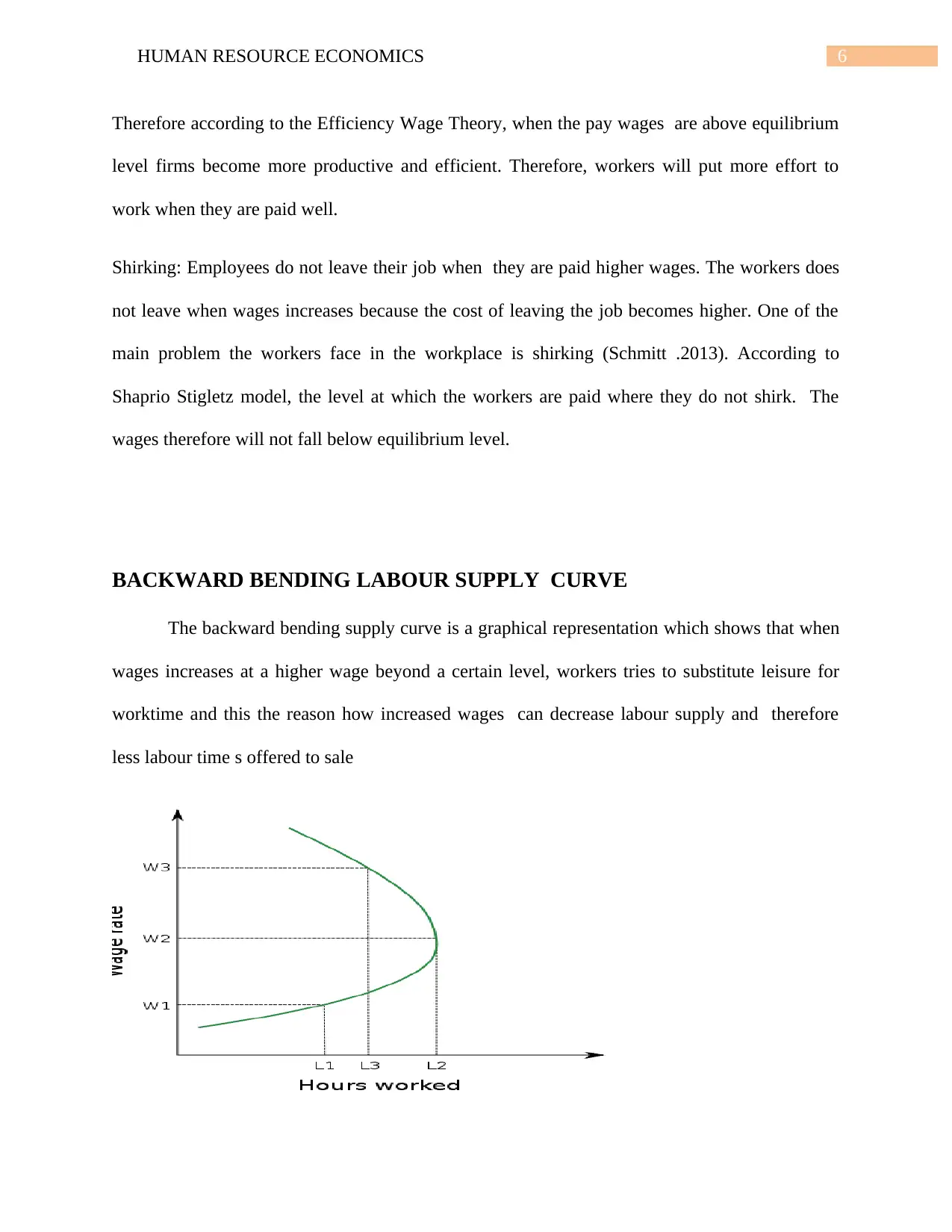
6HUMAN RESOURCE ECONOMICS
Therefore according to the Efficiency Wage Theory, when the pay wages are above equilibrium
level firms become more productive and efficient. Therefore, workers will put more effort to
work when they are paid well.
Shirking: Employees do not leave their job when they are paid higher wages. The workers does
not leave when wages increases because the cost of leaving the job becomes higher. One of the
main problem the workers face in the workplace is shirking (Schmitt .2013). According to
Shaprio Stigletz model, the level at which the workers are paid where they do not shirk. The
wages therefore will not fall below equilibrium level.
BACKWARD BENDING LABOUR SUPPLY CURVE
The backward bending supply curve is a graphical representation which shows that when
wages increases at a higher wage beyond a certain level, workers tries to substitute leisure for
worktime and this the reason how increased wages can decrease labour supply and therefore
less labour time s offered to sale
Therefore according to the Efficiency Wage Theory, when the pay wages are above equilibrium
level firms become more productive and efficient. Therefore, workers will put more effort to
work when they are paid well.
Shirking: Employees do not leave their job when they are paid higher wages. The workers does
not leave when wages increases because the cost of leaving the job becomes higher. One of the
main problem the workers face in the workplace is shirking (Schmitt .2013). According to
Shaprio Stigletz model, the level at which the workers are paid where they do not shirk. The
wages therefore will not fall below equilibrium level.
BACKWARD BENDING LABOUR SUPPLY CURVE
The backward bending supply curve is a graphical representation which shows that when
wages increases at a higher wage beyond a certain level, workers tries to substitute leisure for
worktime and this the reason how increased wages can decrease labour supply and therefore
less labour time s offered to sale
Paraphrase This Document
Need a fresh take? Get an instant paraphrase of this document with our AI Paraphraser
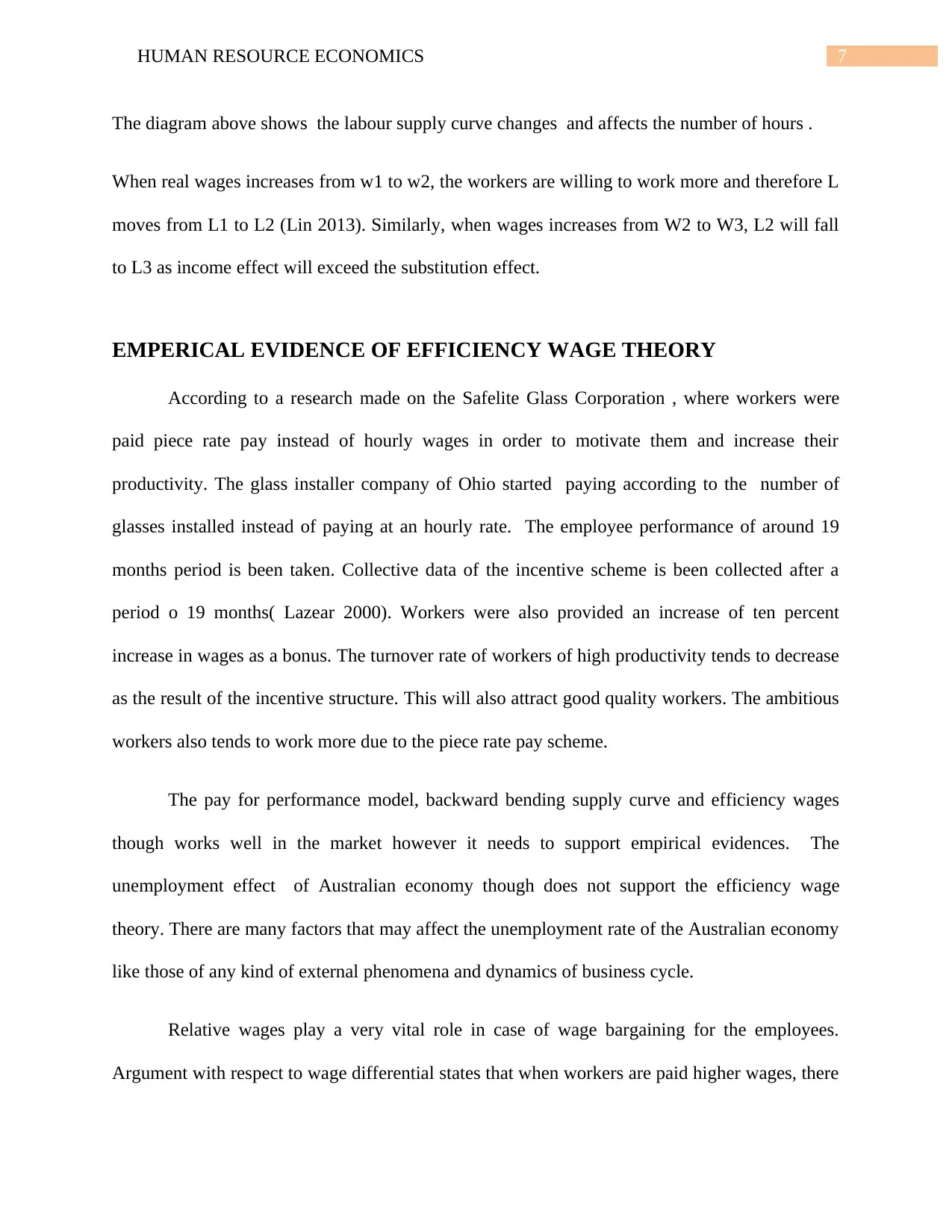
7HUMAN RESOURCE ECONOMICS
The diagram above shows the labour supply curve changes and affects the number of hours .
When real wages increases from w1 to w2, the workers are willing to work more and therefore L
moves from L1 to L2 (Lin 2013). Similarly, when wages increases from W2 to W3, L2 will fall
to L3 as income effect will exceed the substitution effect.
EMPERICAL EVIDENCE OF EFFICIENCY WAGE THEORY
According to a research made on the Safelite Glass Corporation , where workers were
paid piece rate pay instead of hourly wages in order to motivate them and increase their
productivity. The glass installer company of Ohio started paying according to the number of
glasses installed instead of paying at an hourly rate. The employee performance of around 19
months period is been taken. Collective data of the incentive scheme is been collected after a
period o 19 months( Lazear 2000). Workers were also provided an increase of ten percent
increase in wages as a bonus. The turnover rate of workers of high productivity tends to decrease
as the result of the incentive structure. This will also attract good quality workers. The ambitious
workers also tends to work more due to the piece rate pay scheme.
The pay for performance model, backward bending supply curve and efficiency wages
though works well in the market however it needs to support empirical evidences. The
unemployment effect of Australian economy though does not support the efficiency wage
theory. There are many factors that may affect the unemployment rate of the Australian economy
like those of any kind of external phenomena and dynamics of business cycle.
Relative wages play a very vital role in case of wage bargaining for the employees.
Argument with respect to wage differential states that when workers are paid higher wages, there
The diagram above shows the labour supply curve changes and affects the number of hours .
When real wages increases from w1 to w2, the workers are willing to work more and therefore L
moves from L1 to L2 (Lin 2013). Similarly, when wages increases from W2 to W3, L2 will fall
to L3 as income effect will exceed the substitution effect.
EMPERICAL EVIDENCE OF EFFICIENCY WAGE THEORY
According to a research made on the Safelite Glass Corporation , where workers were
paid piece rate pay instead of hourly wages in order to motivate them and increase their
productivity. The glass installer company of Ohio started paying according to the number of
glasses installed instead of paying at an hourly rate. The employee performance of around 19
months period is been taken. Collective data of the incentive scheme is been collected after a
period o 19 months( Lazear 2000). Workers were also provided an increase of ten percent
increase in wages as a bonus. The turnover rate of workers of high productivity tends to decrease
as the result of the incentive structure. This will also attract good quality workers. The ambitious
workers also tends to work more due to the piece rate pay scheme.
The pay for performance model, backward bending supply curve and efficiency wages
though works well in the market however it needs to support empirical evidences. The
unemployment effect of Australian economy though does not support the efficiency wage
theory. There are many factors that may affect the unemployment rate of the Australian economy
like those of any kind of external phenomena and dynamics of business cycle.
Relative wages play a very vital role in case of wage bargaining for the employees.
Argument with respect to wage differential states that when workers are paid higher wages, there
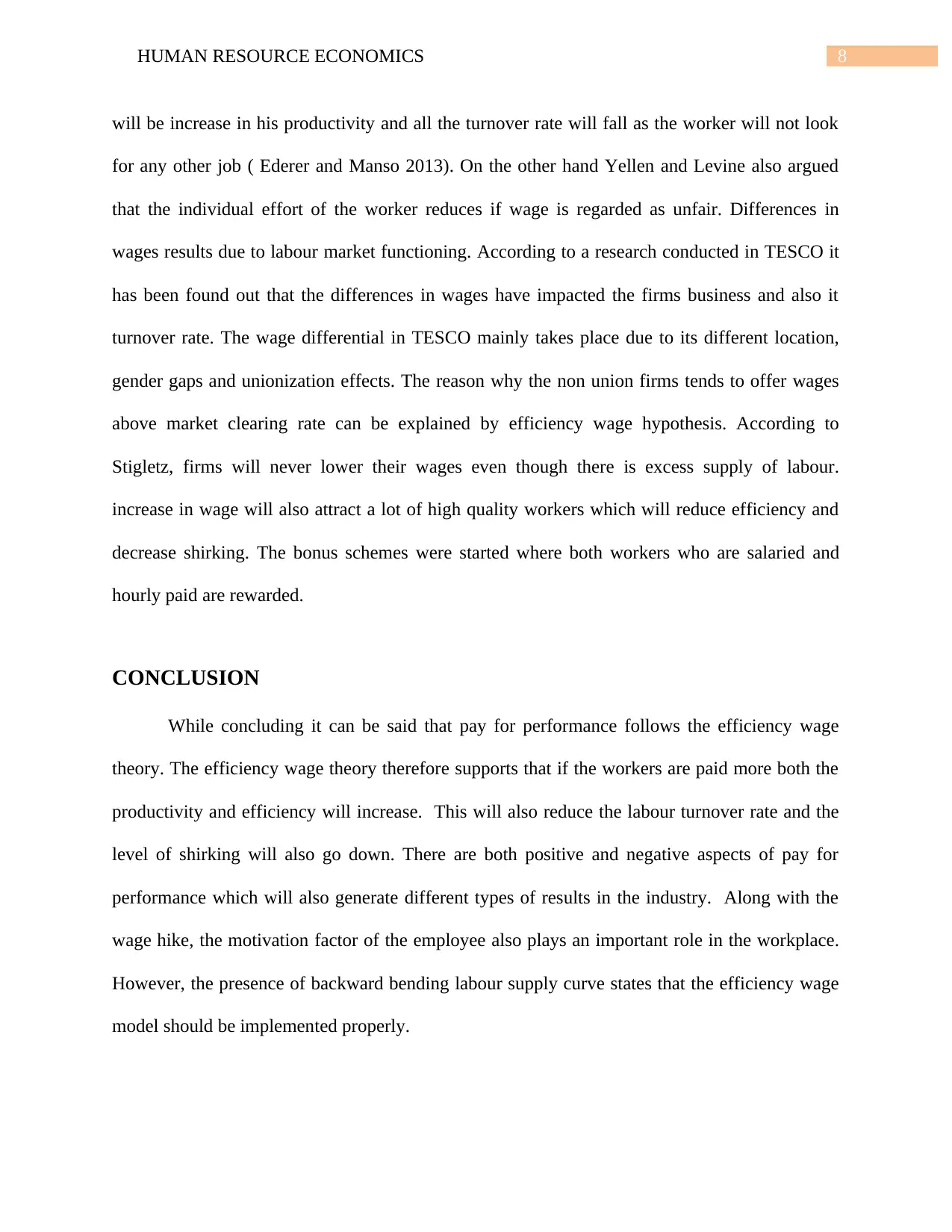
8HUMAN RESOURCE ECONOMICS
will be increase in his productivity and all the turnover rate will fall as the worker will not look
for any other job ( Ederer and Manso 2013). On the other hand Yellen and Levine also argued
that the individual effort of the worker reduces if wage is regarded as unfair. Differences in
wages results due to labour market functioning. According to a research conducted in TESCO it
has been found out that the differences in wages have impacted the firms business and also it
turnover rate. The wage differential in TESCO mainly takes place due to its different location,
gender gaps and unionization effects. The reason why the non union firms tends to offer wages
above market clearing rate can be explained by efficiency wage hypothesis. According to
Stigletz, firms will never lower their wages even though there is excess supply of labour.
increase in wage will also attract a lot of high quality workers which will reduce efficiency and
decrease shirking. The bonus schemes were started where both workers who are salaried and
hourly paid are rewarded.
CONCLUSION
While concluding it can be said that pay for performance follows the efficiency wage
theory. The efficiency wage theory therefore supports that if the workers are paid more both the
productivity and efficiency will increase. This will also reduce the labour turnover rate and the
level of shirking will also go down. There are both positive and negative aspects of pay for
performance which will also generate different types of results in the industry. Along with the
wage hike, the motivation factor of the employee also plays an important role in the workplace.
However, the presence of backward bending labour supply curve states that the efficiency wage
model should be implemented properly.
will be increase in his productivity and all the turnover rate will fall as the worker will not look
for any other job ( Ederer and Manso 2013). On the other hand Yellen and Levine also argued
that the individual effort of the worker reduces if wage is regarded as unfair. Differences in
wages results due to labour market functioning. According to a research conducted in TESCO it
has been found out that the differences in wages have impacted the firms business and also it
turnover rate. The wage differential in TESCO mainly takes place due to its different location,
gender gaps and unionization effects. The reason why the non union firms tends to offer wages
above market clearing rate can be explained by efficiency wage hypothesis. According to
Stigletz, firms will never lower their wages even though there is excess supply of labour.
increase in wage will also attract a lot of high quality workers which will reduce efficiency and
decrease shirking. The bonus schemes were started where both workers who are salaried and
hourly paid are rewarded.
CONCLUSION
While concluding it can be said that pay for performance follows the efficiency wage
theory. The efficiency wage theory therefore supports that if the workers are paid more both the
productivity and efficiency will increase. This will also reduce the labour turnover rate and the
level of shirking will also go down. There are both positive and negative aspects of pay for
performance which will also generate different types of results in the industry. Along with the
wage hike, the motivation factor of the employee also plays an important role in the workplace.
However, the presence of backward bending labour supply curve states that the efficiency wage
model should be implemented properly.
⊘ This is a preview!⊘
Do you want full access?
Subscribe today to unlock all pages.

Trusted by 1+ million students worldwide
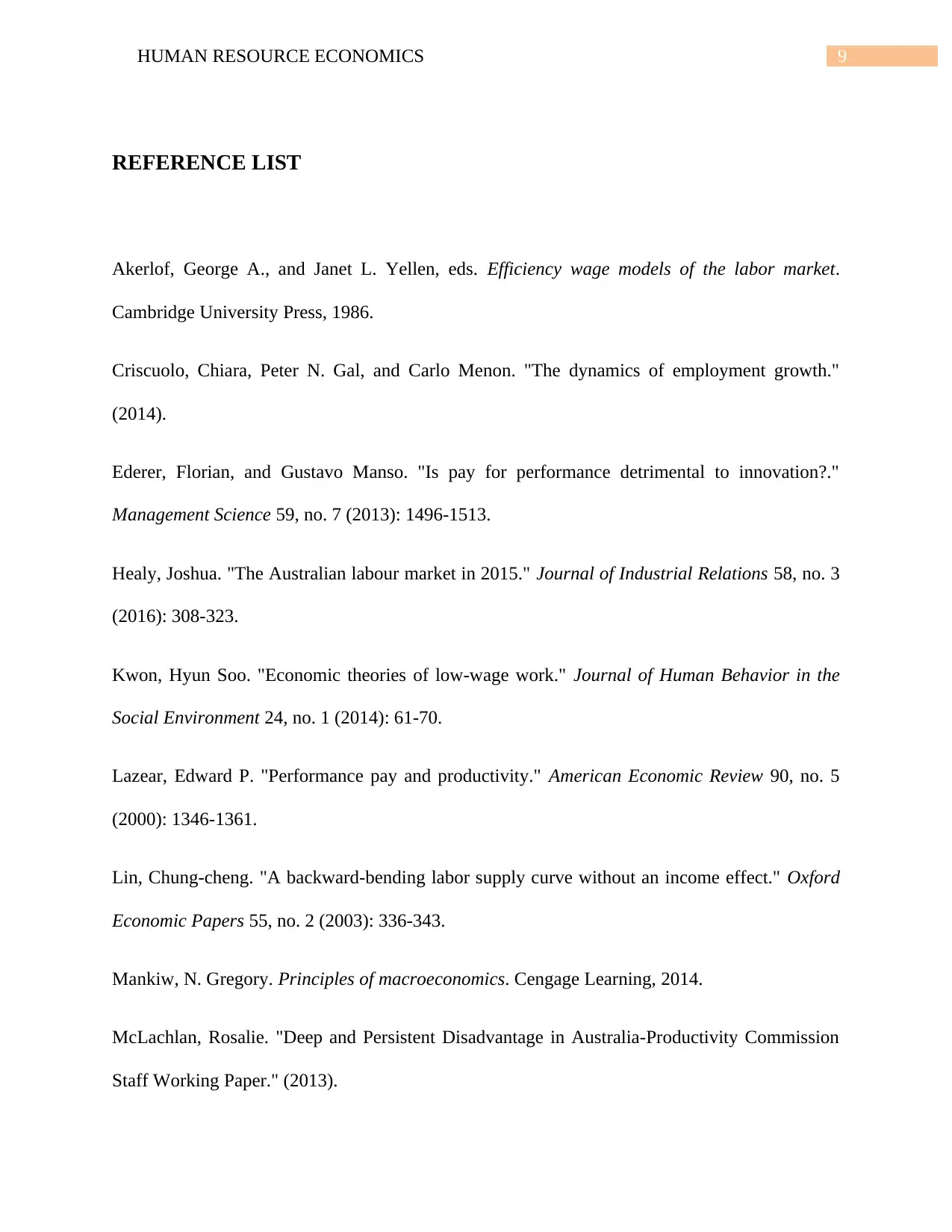
9HUMAN RESOURCE ECONOMICS
REFERENCE LIST
Akerlof, George A., and Janet L. Yellen, eds. Efficiency wage models of the labor market.
Cambridge University Press, 1986.
Criscuolo, Chiara, Peter N. Gal, and Carlo Menon. "The dynamics of employment growth."
(2014).
Ederer, Florian, and Gustavo Manso. "Is pay for performance detrimental to innovation?."
Management Science 59, no. 7 (2013): 1496-1513.
Healy, Joshua. "The Australian labour market in 2015." Journal of Industrial Relations 58, no. 3
(2016): 308-323.
Kwon, Hyun Soo. "Economic theories of low-wage work." Journal of Human Behavior in the
Social Environment 24, no. 1 (2014): 61-70.
Lazear, Edward P. "Performance pay and productivity." American Economic Review 90, no. 5
(2000): 1346-1361.
Lin, Chung‐cheng. "A backward‐bending labor supply curve without an income effect." Oxford
Economic Papers 55, no. 2 (2003): 336-343.
Mankiw, N. Gregory. Principles of macroeconomics. Cengage Learning, 2014.
McLachlan, Rosalie. "Deep and Persistent Disadvantage in Australia-Productivity Commission
Staff Working Paper." (2013).
REFERENCE LIST
Akerlof, George A., and Janet L. Yellen, eds. Efficiency wage models of the labor market.
Cambridge University Press, 1986.
Criscuolo, Chiara, Peter N. Gal, and Carlo Menon. "The dynamics of employment growth."
(2014).
Ederer, Florian, and Gustavo Manso. "Is pay for performance detrimental to innovation?."
Management Science 59, no. 7 (2013): 1496-1513.
Healy, Joshua. "The Australian labour market in 2015." Journal of Industrial Relations 58, no. 3
(2016): 308-323.
Kwon, Hyun Soo. "Economic theories of low-wage work." Journal of Human Behavior in the
Social Environment 24, no. 1 (2014): 61-70.
Lazear, Edward P. "Performance pay and productivity." American Economic Review 90, no. 5
(2000): 1346-1361.
Lin, Chung‐cheng. "A backward‐bending labor supply curve without an income effect." Oxford
Economic Papers 55, no. 2 (2003): 336-343.
Mankiw, N. Gregory. Principles of macroeconomics. Cengage Learning, 2014.
McLachlan, Rosalie. "Deep and Persistent Disadvantage in Australia-Productivity Commission
Staff Working Paper." (2013).
Paraphrase This Document
Need a fresh take? Get an instant paraphrase of this document with our AI Paraphraser
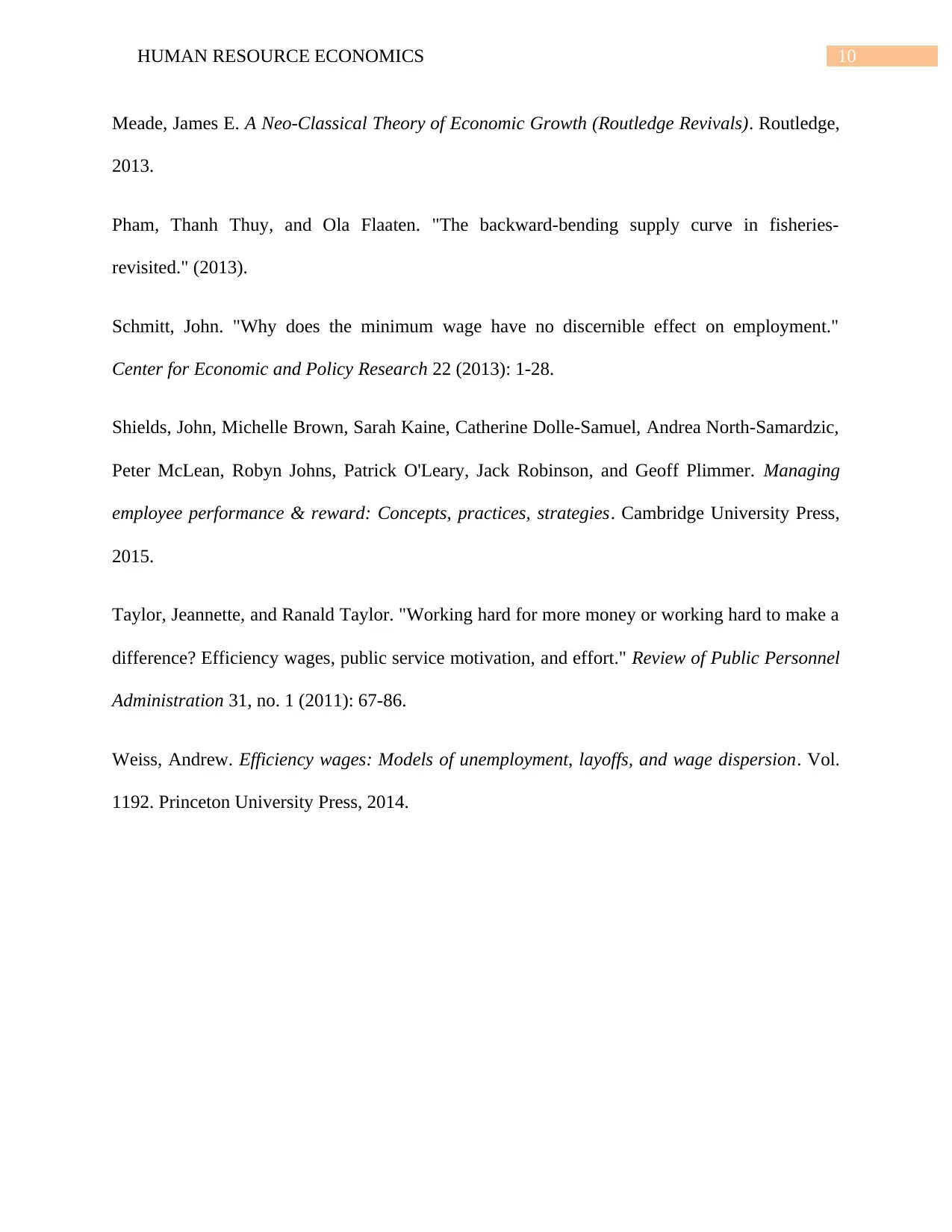
10HUMAN RESOURCE ECONOMICS
Meade, James E. A Neo-Classical Theory of Economic Growth (Routledge Revivals). Routledge,
2013.
Pham, Thanh Thuy, and Ola Flaaten. "The backward-bending supply curve in fisheries-
revisited." (2013).
Schmitt, John. "Why does the minimum wage have no discernible effect on employment."
Center for Economic and Policy Research 22 (2013): 1-28.
Shields, John, Michelle Brown, Sarah Kaine, Catherine Dolle-Samuel, Andrea North-Samardzic,
Peter McLean, Robyn Johns, Patrick O'Leary, Jack Robinson, and Geoff Plimmer. Managing
employee performance & reward: Concepts, practices, strategies. Cambridge University Press,
2015.
Taylor, Jeannette, and Ranald Taylor. "Working hard for more money or working hard to make a
difference? Efficiency wages, public service motivation, and effort." Review of Public Personnel
Administration 31, no. 1 (2011): 67-86.
Weiss, Andrew. Efficiency wages: Models of unemployment, layoffs, and wage dispersion. Vol.
1192. Princeton University Press, 2014.
Meade, James E. A Neo-Classical Theory of Economic Growth (Routledge Revivals). Routledge,
2013.
Pham, Thanh Thuy, and Ola Flaaten. "The backward-bending supply curve in fisheries-
revisited." (2013).
Schmitt, John. "Why does the minimum wage have no discernible effect on employment."
Center for Economic and Policy Research 22 (2013): 1-28.
Shields, John, Michelle Brown, Sarah Kaine, Catherine Dolle-Samuel, Andrea North-Samardzic,
Peter McLean, Robyn Johns, Patrick O'Leary, Jack Robinson, and Geoff Plimmer. Managing
employee performance & reward: Concepts, practices, strategies. Cambridge University Press,
2015.
Taylor, Jeannette, and Ranald Taylor. "Working hard for more money or working hard to make a
difference? Efficiency wages, public service motivation, and effort." Review of Public Personnel
Administration 31, no. 1 (2011): 67-86.
Weiss, Andrew. Efficiency wages: Models of unemployment, layoffs, and wage dispersion. Vol.
1192. Princeton University Press, 2014.

11HUMAN RESOURCE ECONOMICS
⊘ This is a preview!⊘
Do you want full access?
Subscribe today to unlock all pages.

Trusted by 1+ million students worldwide
1 out of 12
Related Documents
Your All-in-One AI-Powered Toolkit for Academic Success.
+13062052269
info@desklib.com
Available 24*7 on WhatsApp / Email
![[object Object]](/_next/static/media/star-bottom.7253800d.svg)
Unlock your academic potential
Copyright © 2020–2025 A2Z Services. All Rights Reserved. Developed and managed by ZUCOL.





